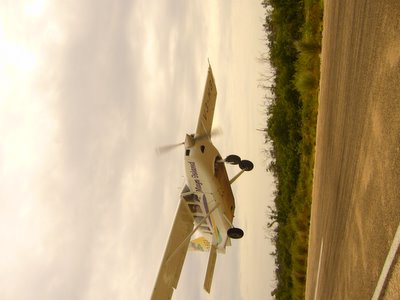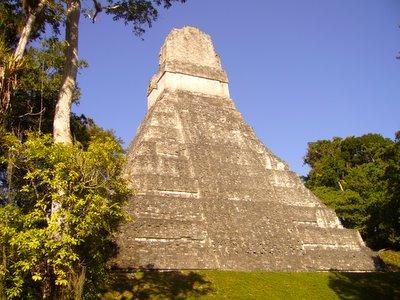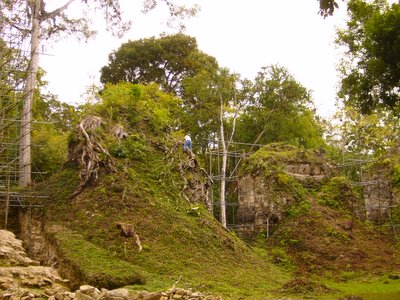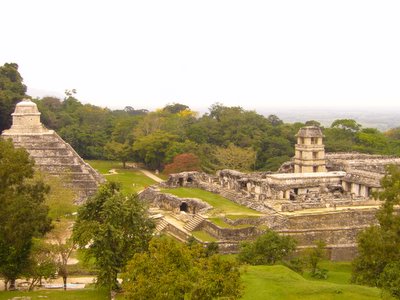I'm writing this on the Caribbean Island of
Caye Caulker, off the coast of Belize, where I arrived yesterday. It seems so long since I last wrote an entry that I'm not sure where to start, so I think I'll go for the beginning . . .
I did bump into that tedious Swiss bloke again, at an archeaologically-themed restaurant run by a German with a
Jeremy Beadle beard and disconcertingly high-waisted trousers. While I was eating my meal a bus-load of German tourists turned up for a slide show about the local Mayan ruins. I sat through it, and found that despite the language barrier I could more or less follow what was going on by looking at the pictures. The only problem was the Swiss bloke constantly interrupting the talk to tell me how much better the ruins were when he visited them thirty years ago. After the talk he had some questions for the owner, who obviously knew how boring he was and didn't want to talk to him. There was a strange farce for about an hour with the restauranteur darting around making excuses while being stalked by this old hippy in his filthy Snoopy vest. Later in the evening I got so annoyed with the bloke I had a go at him about his nation's complicity in the second world war. I admit my arguments were flimsy, but it was satisfying to accuse him of being a money-grabbing coward, at least by proxy.
It was another early start in the morning for the bus over the border. This was an ancient school bus, of the sort that you see on old black-and-white American movies. The driver was obviously hoping his boss would buy him a new one if it broke, so he drove it like a thing possessed, ignoring potholes, speedbumps and anything else that stood in his way. We were soon at the border. As soon as we arrived the low-life money changers started reaching through the windows with their big bunches of filthy old banknotes. It was quite an unsettling experience - because of the strong competition between them they all wore looks of desperation on their faces as they furiously waved their tattered cash at us. By this time it was raining quite heavily, and the no-man's land between the Guatemalan exit and the Belizean customs house was a 400-yard dash across a carpark running with water. Below is a photo of me having just got through the two-hour process of crossing the border, enjoying the fabulous Caribbean climate.

It was a shame that the windows of the bus were filthy and running with rainwater, because I found my first glimpse of Belize absolutely fascinating. Really, it's no different from the the parts of Mexico and Guatemala I've seen, but it is somehow, slightly, subtly British. For example the tiny huts that villagers live in are much the same, but here they are more often fenced and with neater gardens. They may still be shacks the size of the average garage, but they are, nonetheless, somebody's castle. Other differences: the signage (in English) is a lot less garish. The horses, which seem to be in every field, are much better fed and groomed. (I saw quite a few in harness being driven two in hand, a difficult skill - elsewhere I've been there's only ever been one horse per cart.) Also, like in Britain, fly-tipping is a national pastime - every hundred yards or so there would be a an old cooker or fridge rusting by the side of the road. Perhaps the most surprising thing for me was the huge Chinese influence. Every single supermarket is called something like Chang's or Wing's or Happy Joy Luck Dragon or something. I also saw some German Mennonites, a Dutch-German sect, much like the Amish in America. About 3,000 of them moved here in 1959 to practice their peaceful agricultural ways and avoid paying tax (because, they say, if they pay up it might mean accidently supporting war or some other un-godly things). The two men were wearing matching costumes of blue shirt, red braces and black trousers, topped off with a crisp, clean Panama hat. The women were both wearing blue dresses and headscarfs. Both squinted through thick glasses and had babies tucked under their arms. They were in a crazy old pick up truck, cobbled together from rusty panels of different colours. The majority of the population here are the descendants of early Spanish settlers, British (particularly Scottish) pirates, Mayans and Africans - all mixed up in various combinations. They seem a jolly bunch, apparently untroubled by the usual racial heirarchies you often get in this neck of the woods.
Before too long we were dropped off in Belize, next to its (apparently) famous swing bridge (the only working example in the world, which was built in Liverpool in the 1920s). The first thing I did (along with two very sweet Swiss girls whom I'd met on the bus) was find a cashpoint to get some cash. A note on the money: because Belize is in the Commonwealth, and the Queen is still head of state, she is on all the coins and notes. The strange thing is that since the country was granted independence in 1981 they haven't changed her portrait; so it's a much younger and quite foxy-looking Ma'am you see when you pay for anything.
Then, it was to the water taxi pier to get to Caye Caulker, which I hadn't intended to go to, but was told by everyone on the bus that it was worth at least a day before I did anything else. It was raining even more heavily by this time, so after all the passengers had crowded onto the boat the captain spread tarpaulin over them all to protect them from the rain and spray (the sea was very choppy). Unfortunately I had been all very polite about getting on and so there was no room for me under the tarp. So among this brightly coloured mosaic of plastic sheeting and cagoules there was one Englishman sitting behind the captain (who was in a yellow all-in-one waterproof) wearing his warmest clothes - a tweed jacket, a blue woolley hat (with an embroidered penguin on it) and a chequered scarf. A group of French people (I think you can see some of them waving in the picture below) found this highly amusing.

The trip took about an hour, and I did get absolutely soaked - but I loved it, even though I now know what the Viking saga writers meant when they wrote about 'stinging salt spray'. We weaved through lots of little Cayes, which are tiny islands, usually covered in mangrove forests rising straight out of the azure sea. In places individual trees stood out of the shallow water, which I found a strangely unsettling (they reminded me of an awful nightmare I once had about an evil dwarf with a blowpipe). I suppose one day, when these isolated trees have put down enough roots and dropped enough leaves, they will create new islands. Caye Caulker is already relatively large, with a white sandy beach along the shore and a very nice ramshackle little town, pictured below.

Even though the island is only the size of a couple of cricket pitches, I managed to get hopelessly lost when I went for a walk today. Looking back, I was heading south into the mangrove swamps instead of north to the main beach, where, I'm told, a cafe sells lashings of the most wizard ginger beer. The winding path I was following got thinner and thinner until it disappeared totally, so I faced the choice of either doubling back on myself or pushing my way to the shoreline through the dense thicket. I chose the latter. The last stretch I had to take at a run, in order to hop from dry spot to dry spot. And I so it was I found myself bursting out onto something that looked like a motorway. A moment later I realised what the humming noise I had been hearing was: I was standing on a runway, with a light aircraft accelerating towards me. Fortunately I had my camera in my hand, so I was able to snap this picture of the plane as it banked to the left to avoid the strange pink creature that had just lurched out of the undergrowth.

The Cayes run for most of the shoreline of Belize and are part of the worlds largest barrier reef, second only to Australia's. I think they must have been hit by hurricane Katrina, because all round the shore are piles of flotsam (or is it jetsam?) and ripped-up mangroves. The picture below is the sort of thing that retired teachers send into magazine photographic competitions - environmental ruin behind, poignant washed-up sign, and new life sprouting in the foreground. Positive meditation indeed.

Caye Caulker defines itself as a Rasta town. I loved this painted-up truck below. Jah rule, indeed.

Anyway, I and I really has to stop writing now because internet connection here is horrendously expensive (about six quid an hour). I also need to get going to meet up with the two Swiss girls for dinner. I may be off-line for a couple of days, not so much because of the expense, but because I'm going to be relaxing for a while and probably won't have much of interest to say. On Saturday I'm planning to join a three-day sailing trip down the coast (camping on cartoon-style desert islands) back towards Guatemala.
 This is the cathedral in Leon, which took a hundred years to build, from 1747, and is the largest in Central America. Local legend has it that the city fathers feared the Spanish authorities would refuse such a big project, so they submitted bogus plans showing a much smaller building. When this was approved they went ahead with their grandiose plans.
This is the cathedral in Leon, which took a hundred years to build, from 1747, and is the largest in Central America. Local legend has it that the city fathers feared the Spanish authorities would refuse such a big project, so they submitted bogus plans showing a much smaller building. When this was approved they went ahead with their grandiose plans.  Leon has quite a radical edge to it - it´s very much the heartland of Nicaragua´s socialist traditions. Murals of Che Guevara are all over the place along with monuments to fallen comrades. Below is the Gallery of Heroes and Martyrs, which contains photos of some of the people killed by the Contras - a guerilla army funded for years by the CIA using drug money and cash from illegal arms sales to Iran. Whereas we remember him as a bit of a bumbling old fool, Ronald Reagan is a real bogeyman here.
Leon has quite a radical edge to it - it´s very much the heartland of Nicaragua´s socialist traditions. Murals of Che Guevara are all over the place along with monuments to fallen comrades. Below is the Gallery of Heroes and Martyrs, which contains photos of some of the people killed by the Contras - a guerilla army funded for years by the CIA using drug money and cash from illegal arms sales to Iran. Whereas we remember him as a bit of a bumbling old fool, Ronald Reagan is a real bogeyman here.  This is Sarah and Lydia at a beach party we hitched to and gatecrashed with Alex and Jeremy, the lads from Canada. Dancing on sand is great fun, but quite difficult. You tend to bore down as you shimmy and become trapped up to the ankles, so the slightest nudge from another dancer sends you toppling over. There was quite a surreal interlude during the evening when the music stopped and two burly blokes ran onto the stage brandishing dildos. They then started putting condoms on their heads and rolling them up their arms - presumably as some sort of AIDS education programme. They didn´t notice when Alex sneaked up onto the stage behind them and started accompanying their bizarre display on the drums. He did a good job too.
This is Sarah and Lydia at a beach party we hitched to and gatecrashed with Alex and Jeremy, the lads from Canada. Dancing on sand is great fun, but quite difficult. You tend to bore down as you shimmy and become trapped up to the ankles, so the slightest nudge from another dancer sends you toppling over. There was quite a surreal interlude during the evening when the music stopped and two burly blokes ran onto the stage brandishing dildos. They then started putting condoms on their heads and rolling them up their arms - presumably as some sort of AIDS education programme. They didn´t notice when Alex sneaked up onto the stage behind them and started accompanying their bizarre display on the drums. He did a good job too. This is the cathedral in Grenada. Whereas Leon is the spiritual home of the Nicaraguan left, this town has always been much more Conservative. At the moment there are builders everywhere improving roads, refurbishing houses and generally tidying the place up. I could imagine that within a few years this will become a playground for the very rich - it´s already beautiful and it threatens to become blindingly gorgeous.
This is the cathedral in Grenada. Whereas Leon is the spiritual home of the Nicaraguan left, this town has always been much more Conservative. At the moment there are builders everywhere improving roads, refurbishing houses and generally tidying the place up. I could imagine that within a few years this will become a playground for the very rich - it´s already beautiful and it threatens to become blindingly gorgeous.



























